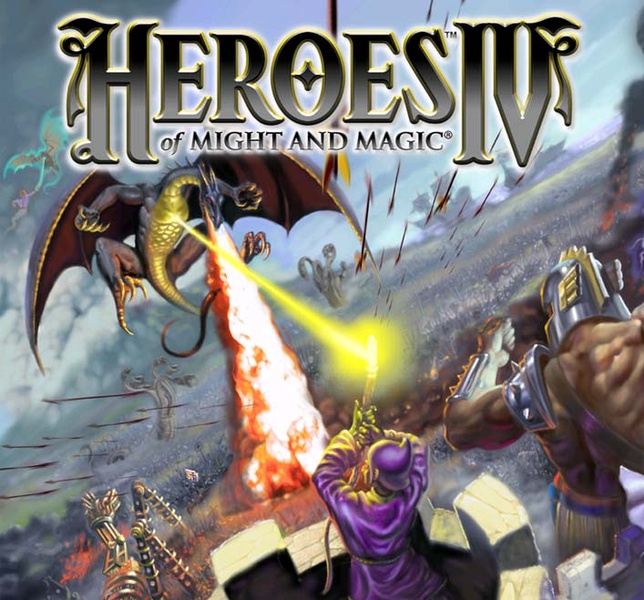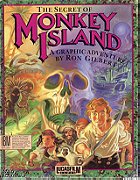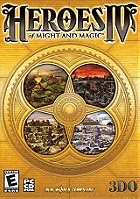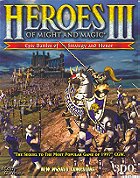Posted : 12 years, 11 months ago on 7 February 2013 07:36
(A review of
My Background with this Game:
With this installment of the Heroes of Might and Magic franchise, a huge schism was created among the fan base. On one side, there were the series traditionalists, those who loved the status quo of the traditional formula, who hated the large deviations this game took from those, and who cried foul to 3DO for creating this rendition of a Heroes game. For others, this game gave them so many of the features they had always wanted, always wondered how they would work, and created an entirely new feel to a franchise they already loved. I do not know how many were in the middle, how many loved both versions of the game, though I would venture that more on the side who loved the new version also loved the more traditional versions as well.

For myself and my friends, we embraced the changes, not as something better, but as something equally fun. Many of the same features that made the previous installments so replayable returned, including one of my favorites, hotseat mode. But there was much new to learn here, and not the least of it was the logistics of army movement, which were changed immensely. While there are many new features and changes, the formula I mentioned previously in my review of Heroes III is still intact: choose a faction in the chosen given for a scenario, or the one selected for the campaign you’re playing, building your town and gather resources, and conquer the map via one of a number of requirements. And while that is the same, many of the new features reveal new strategies, and old strategies that worked no longer function in this brave new world. And by brave new world, I mean that quite literally. The plot introduces us to a completely new world. But that explanation is for another section.
Plot:
As with the previous review, I’ll keep the plot for this game relatively brief, as a part of the fun, especially for the campaigns, is watching the plot unfold. To be brief, this world begins with the end of the Heroes Chronicles series. Gelu, the elf leade of Avlee, has sought out Kilgor, the barbarian leader, with the hope of destroying the Sword of Frost with the sword he claimed in the previous series, Armageddon’s Blade. The clashing of these two swords destroys Enroth, but luckily, refugees from each kingdom are able to escape its destruction by mysterious portals that lead them to Axeoth, an entirely new world.
And so this game’s plot really begins, with the six campaigns telling the stories of how each of the six factions great leaders emerged in this new world. Unlike the previous Heroes game, however, you’re able to play any of the campaigns from the very start, each telling its own self-contained tale. The plot for this Heroes game follows that of the Might and Magic IX game, a game with some various flaws and some major changes of its own from the previous Might and Magic games. I won’t say it’s my favorite of the series, but patched up, it’s an enjoyable enough game to play through at least once. My personal favorites were Might and Magic VII and VIII. Not really sure which I enjoyed more, but perhaps I’ll consider that in future reviews. In any case, I’d highly recommend any of those. For the Heroes IV game I’m reviewing here, the plot of the campaigns explores this new world, though much like previous Heroes games, the individual scenarios do not.
Gameplay:
The Basics
As mentioned in my previous review of Heroes III, this game changes some of the core values of the Heroes universe. But before I get into the specifics of those changes here, much does remain the same. As before, the actual starting positions and resources change from map to map, and the gameplay revolves around the same simple formula: build up a starting town (sometimes you have to claim an unoccupied town at the start) to unlock more powerful creatures. To build, you require resources beyond the gold your town generates. These are secured by a hero and army that you use to explore the map with, encountering random creatures to fight, resource mines to claim, random piles of resources or treasure chests to find, and town (both unoccupied and occupied) to claim. As your army and resources grow, you will likely have multiple armies. You will also encounter rivers and lakes to cross, by means of ships (these require all of your movement to board and disembark from, adding to your strategy overland).
Differences from Previous HoMM
However, even with these similarities, many, many changes exist. One controversial change was the growth of new creatures. Whereas in the previous games, creature growth occurred once a week, in this version, creature structures produce some creatures each day. Your town tells you how many to expect each week, and each day averages 1/7 of that number. This obviously changes the strategy of the game immensely. The urgency of claiming a town before an enemy receives a new influx of creatures at the beginning of the next week is gone. Being caught without any creatures in town becomes far less likely, although against a large army, the few creatures you receive in a day or two is not likely to do much. On the other hand, with some resourcefulness and luck, it can enable you to defeat armies you might not thought possible, and thus save your town, whereas in the other version, if you took all creatures out with you at the start of a week, you’re simply out of luck.
And the creature structures? They’ve received their own facelift in this game. Gone are the creature upgrades. There are none in this version of HoMM. In its place is an option choice. Except for level one creatures, in which you can build two, each of the other three level creatures (levels two through four), you can only build one of the two options. For example, in my favorite order castle, I can build either a titans structure or a dragon golem structure. I can never have both. This allows you to craft different strategies for your army based on creature choices within that particular town. Personally, I enjoy this feature, though I do admit, the choices you make are often the same, based on your preferred style of combat. But then, if you don’t have choices but have the same creature structures every time, it’s not really that large a change anyway. Of course, there are fewer creatures in this setup, and that I do mourn.

Along with choice of creatures was the option to have hero-less armies. No longer were heroes required in an army. You can have numerous armies roaming, collecting random resources lying about and exploring the map, or eliminating fog of war. And fog of war exists, even after you explore an area. Unlike previous Heroes games, where fog of war was gone once you explored an area (with the exception of the Necro town structure and a few other structures/spells that brought some of it back to a limited area), in this Heroes, once you explore an area, you can see whatever is there on the map, but you cannot see creatures or enemy heroes move. This creates a greater necessity to station creatures inside mines and at wall gateways to allow you to see movement at key locations on the map. Though of course, if you can have hero-less armies, the opposite is also true. You can have creature-less armies, composed of as few as a single hero. This was made possible in large part by another large change, and probably one of the most controversial of them all: heroes in combat.
Whereas in previous Heroes games, your hero was a sideline general, contributing stat boosters, spells, and some various other benefits from skills, heroes in this version are present on the actual battlefield. They battle alongside your creatures. This new feature brings with it many positives and some negatives as well. For one large negative, there can be a balance issue at times with the heroes. Heroes can develop into wrecking machines, capable to taking out an entire army by themselves, with some help from immortality potions. There are many on the one side who proclaimed this feature broken. Either your heroes were useless at the beginning, dying far too easily, or your heroes were overpowering. I won’t deny, there were some times where my hero was overpowering, or was overpowered by the enemy AI. But I am not one who believes this feature is broken. I believe this adds to possibilities of the game, but I will expound more on that in the section on Battling.
Along with heroes in battle, we have an entirely new system of skill development. It still utilizes a similar approach in having random skill options each level, but there are now 9 different primary skills and each of those has three subskills. To learn any of the subskills, you must learn the primary skill first. In addition, each skill has five levels of development, as opposed to the original three. Of the nine primary skills, five correspond to the five magics that now make up Axeoth’s world: life, nature, order, chaos, and death. The other for correspond to combat and other areas of the game, such as map movement, creature and resource growth, tactical advantages in battle. Heroes can now only have five groups of skills, so you must choose which you want for them. Each hero starts with the same skills for its alignment. If it’s an Order mage, it has order magic and a subskill. If an Order lord, it has Nobility and a subskill. As you level you have a random chance to learn more subskills or a new primary skill, as long as you have an open primary slot. But, in addition to all this, different combinations of skills evolve your hero into a new class. So your Order Mage could evolve into a Monk with Order and Life skills. Each advanced class provides an additional ability/bonus. With such a system, the choices are increased exponentially. Each town has two types of heroes, a magic class hero and a combat class hero. The exception to this is the might faction, which has only combat class heroes. All of this makes for an interesting development in the game. It’s true, you tend to find classes you like best, but that’s with any game. Personally, I love this feature, and enjoy trying different classes at times. My personal favorite is the Archmage, a hero who specializes in all magics. Quite tough to develop far enough, but also quite powerful.

Beyond skill development, there were some tweaks to spells available (gone is an old favorite, dimension door; still, I don’t really miss it much in this version), along with some bonuses for castle defenders, but those topics belong in another section, which I’ll turn to shortly: Battling. For now, I’ll round out this section with some discussion of the map choices and AI.
There are from 1 to as many as seven other computer opponents who will be exploring the map doing the same things. The AI on this game is not quite so difficult as that of the previous Heroes game. This could partly be a result of the AI making at times poor use of advanced strategies, poor use of hero skill development, but whatever the case, the AI is not quite so fearsome, at least not that I found. But, it is still light years ahead of the AI for Heroes V. I won’t even go there beyond to say that..no, in fact, I won’t go there. I won’t give that AI the benefit of a response. Disadvantages work much the same as in previous ones as well, with regards to harder difficulty equals less money, resources, and town structures. But town income is also lessened, as the max income from a town is now 1000, as opposed to up to 4000 for a capital in HoMM III. Winning requirements remain the same, however: To win, you complete whatever map requirements there are. These can range from conquering all the enemy towns to locating a specific artifact, finding a specific location, taking a specific town or defeating a specific hero, etc.
Alignments

Each map in HoMM IV will possess one of six possible faction, down from the nine possible in HoMM III. One of the biggest losses from this was the separate demonic and undead towns, which are now combined into one. Oddly enough, I was never much into the necro towns until Heroes V, after which it became my favorite. In this rendition, not so much. The six factions have their own strengths and weaknesses, and each specializes in a different magic, with the lone exception of the might faction. The six factions are: the Haven town, allied with Life magic, devoted to healing and protection spells. This is mostly the human faction, with a few non-human creatures; the Academy, allied with Order magic, devoted to counter magic and mind control spells. This is a mix of magical creatures, with some traditional races, such as halfings and dwarfs; the Necropolis, allied with Death magic, devoted to necromantic and curse spells. These creatures are either demonic or undead; the Asylum, allied with Chaos magic, devoted to damage and offensive spells. The creatures are a mix of swamp and underground dwelling creatures; the Preserve, allied with Nature magic, devoted to strengthening and summoning spells. The creatures are all of nature, often magical in nature; the Stronghold, allied with no magic and devoted to might heroes and creatures. Most towns have “neutral” creatures of their own alignment. These often possess creature structures outside of towns at times, though some do not and cannot be purchased anywhere. My personal favorite of these is the Academy. Seriously, give me an Order mage with a Ring of Greater Negation and the Hypnotize spell, and I can beat virtually any army. Okay, so that is a clear example of an overpower hero, but quite frankly, I don’t care =)
Battling
Fighting in this game is in many ways quite similar to previous renditions. You face off on opposite sides of a grid. The hexagon grid of the earlier HoMM games is gone, replaced by a square grid. Of all the changes, this one makes it most difficult to plan in combat. It is often difficult to tell if you are truly guarding a unit from arrow fire, or if they can see right past you to the back unit you are protecting, often times being your weak hero! This is one of the areas I did find a bit annoying at times, but overall, it’s not a huge deal. As before, creatures have speed, health, attack, and defense stats, and are either large or small (taking up one or more squares). Creatures can have from one to several unique abilities, much like the previous HoMM, but in this game, retaliation occurs at the same time, except for creatures with first strike abilities. This makes for far different strategies, since you can no longer counter on killing an enemy untouched each time. And with heroes in combat, it can also alter your strategy. A powerful combat hero can save you many creature lives, but a weak one must be protected at all cost, that is, if you want to claim mines or conquer towns. Dead heroes are not sent to prison unless the entire army is defeated. Otherwise they remain in the army, but well, dead. Unlike previous HoMM games, heroes are not sent to the tavern to be repurchased. They are either sent to prison, if defeated by an enemy army, or remain on the spot of your army’s defeat, if killed by a neutral random creature. This means having to take another army out to reclaim that hero, or cut your losses and leave him to his fate.

As mentioned, heroes fight in combat here. They do so quite well, if they have good combat skills and/or good equipment. In addition to spell effects, however, they also have skills that provide bonuses even beyond combat skills. One group, tactics, provides additional stat boosts to creatures, speed and movement boosts, and luck/morale boosts. These can provide huge advantages in battles. With some good equipment that can boost spell effectiveness or give other abilities, and some potions, such as the favorite immortality (only saves you from death once, but with enough of them..well, you get the picture), the heroes can turn the tide quite literally in more ways than previous HoMM games. Is this new style of battle with heroes better? Not necessarily, but nor is it worse. It’s simply different, and to my mind, it’s an insanely fun different. Spells are still a core part of the game; in fact, as I mentioned above, they can be quite devastating. A close friend of mine always preferred the damaging and powerful effects of Chaos magic, including a spell that incinerates your hero, erasing him completely, if he is killed by the spell. Beyond that, there are mass spells, just as in HoMM III, such as mass bless, mass luck, etc, but these are individual spells to be learned, and are not granted by advanced skills, as in previous HoMM games. All in all, I believe that hero skills and combat role expansion has added greatly to the depth of strategy in the game, while providing a differently feel. Again, not necessarily better, but certainly hugely enjoyable.
Last, before I end this section on Battling, I must mention sieges. In previous HoMM games, defending a castle was a huge advantage. Beating down the walls took time, all the while additional damage was down by archer towers from creatures you never had to buy! (well, beyond building the castle upgrade). In this version, there are tower structures, as in previous heroes games, but you must man them with your own creatures. Don’t have enough shooters to man them? Oh well for you. They do provide large defend and offense bonuses, even to melee combat, but they also expose your units to fire from the enemy. If your creatures are not in a tower and not next to the castle wall, you can’t be hit by enemy fire (well, some area damage spells can hit you, if they can hit another creature that is exposed). So yes, all in all, not nearly so many advantages. And the AI can be dumb in sieges as well. Have some awesome illusion spells? Go ahead and create a huge stack of illusionary titans while the enemy stays huddled up in the castle doing nothing. Granted, this is only if they don’t have any shooters or worthwhile creatures to bring out, and on harder settings, it’s not quite so bad, but all the same, it is a flaw that exists in the system.
Multi-player
Multiplayer works much the same here as it did in previous heroes games, and for me, that is just fine. I loved it in the earlier version. Again, I can’t speak to the online play of this version, as I never used it. My friends and I always gathered around one PC, playing much the same way we would a console game, and for this HoMM game, it works just as beautifully. You could also play LAN, though I don’t know anyone who did, but the hotseat option is amazing. Turns take a relatively short time in HoMM IV, much as in previous versions, and that makes this one playable in multiplayer, even for very long games. Personally, I wish there were more hotseat games that worked on PCs. I know MMOs are all the rage now, but quite honestly, even if I were into those, I know I would find it annoying to try coordinating so many various people to gather at the same time online. I don’t know how many hours another friend wasted on WoW just waiting for his clan members to show up for a raid! No, I’ll stick with local gatherings of friends to game in one place. I may be missing out on a larger world experience of MMOs, but I don’t really miss it. For me, this hotseat ability makes this one infinitely replayable.
Conclusion
I don’t believe I need to alter my conclusion from the other HoMM III review, so here it is:
Overall, I would highly recommend this game. I would list here all of the things I love about this game, but I believe I already have given a good measure of that above. This game is still available, including an updated version playable on newer systems courtesy of Ubisoft. I enjoyed some of Heroes V (Ubisoft’s first offering in the series), but have not played the newest version, Heroes VI, which has horrible reviews and issues, not the least of which is the Steam requirement.



 Login
Login
 Home
Home 57 Lists
57 Lists 3 Reviews
3 Reviews Collections
Collections
 0 comments,
0 comments, 









